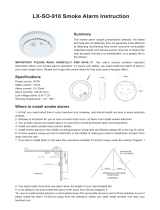
FIVE YEAR LIMITED WARRANTY
KIDDE Safety warrants to the original purchaser that the enclosed
smoke alarm (but not the battery) will be free from defects in material
and workmanship or design under normal use and service for a period
of three years from the date of purchase. The obligation of KIDDE
Safety under this warranty is limited to repairing or replacing the smoke
alarm or any part which we find to be defective in material, workman-
ship or design, free of charge to the customer, upon sending the smoke
alarm with proof of date of purchase, postage and return postage pre-
paid, to Warranty Service Department, KIDDE Safety, 1016 Corporate
Park Dr., Mebane, NC 27302.
This warranty shall not apply to the smoke alarm if it has been dam-
aged, modified, abused or altered after the date of purchase or if it fails
to operate due to improper maintenance or inadequate AC or DC elec-
trical power.
THE LIABILITY OF KIDDE SAFETY OR ANY OF ITS PARENT OR SUB-
SIDIARY CORPORATIONS ARISING FROM THE SALE OF THIS SMOKE
ALARM OR UNDER THE TERMS OF THIS LIMITED WARRANTY SHALL
NOT IN ANY CASE EXCEED THE COST OF REPLACEMENT OF SMOKE
ALARM AND, IN NO CASE, SHALL KIDDE SAFETY OR ANY OF ITS PAR-
ENT OR SUBSIDIARY CORPORATIONS BE LIABLE FOR CONSEQUENTIAL
LOSS OR DAMAGES RESULTING FROM THE FAILURE OF THE SMOKE
ALARM OR FOR BREACH OF THIS OR ANY OTHER WARRANTY, EXPRESS
OR IMPLIED, EVEN IF THE LOSS OR DAMAGE IS CAUSED BY THE COM-
PANY’S NEGLIGENCE OR FAULT.
Since some states do not allow limitations on the duration of an implied
warranty or do not allow the exclusion or limitation of incidental or con-
sequential damages, the above limitations or exclusions may not apply
to you. While this warranty gives you specific legal rights, you may also
have other rights which vary from state to state.
Also, KIDDE Safety makes no warranty, express or implied, written or
oral, including that of merchantability or fitness for any particular pur-
pose, with respect to the battery.
The above warranty may not be altered except in writing signed by both
parties hereto.
QUESTIONS OR FOR MORE INFORMATION
Call our Consumer Hotline at 1-800-880-6788 or contact
us at our website at
www.kidde.com
Kidde, 1016 Corporate Park Drive, Mebane, NC 27302




















